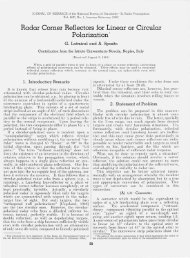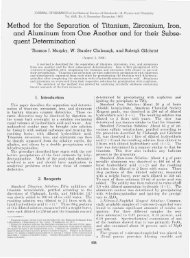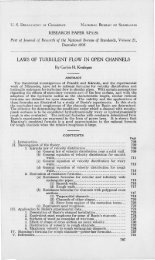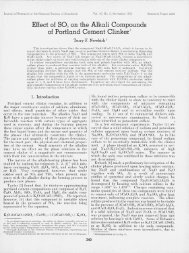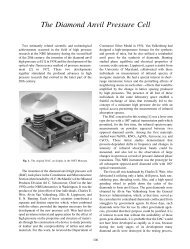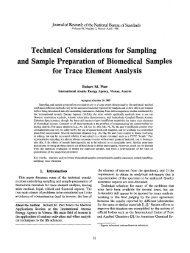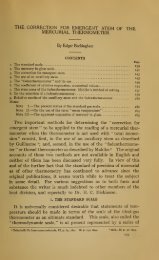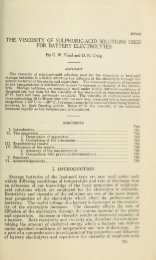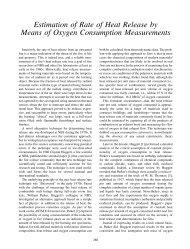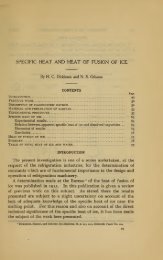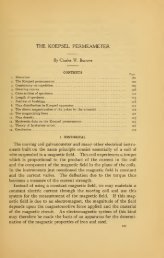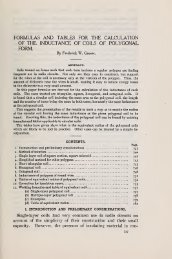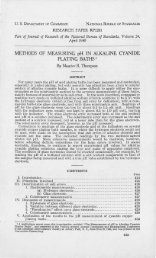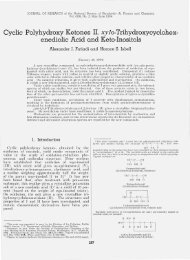Benzoic acid as an acidimetric standard
Benzoic acid as an acidimetric standard
Benzoic acid as an acidimetric standard
Create successful ePaper yourself
Turn your PDF publications into a flip-book with our unique Google optimized e-Paper software.
BENZOIC ACID AS AN ACIDIMETRIC STANDARD<br />
By George W. Morey<br />
The study of the suitabiHty of benzoic <strong>acid</strong> <strong>as</strong> a primary st<strong>an</strong>d-<br />
ard in <strong>acid</strong>imetry <strong>an</strong>d alkaHmetry w<strong>as</strong> suggested by experience<br />
gained in the ptirification of benzoic <strong>acid</strong> to be used <strong>as</strong> a calori-<br />
metric st<strong>an</strong>dard. During that work it w<strong>as</strong> found that benzoic<br />
<strong>acid</strong> could be titrated with st<strong>an</strong>dard alkaH to a high degree of<br />
accuracy, <strong>an</strong>d that this titration afforded the most rapid <strong>an</strong>d<br />
accurate method of comparing the purity of various samples.<br />
Since pure benzoic <strong>acid</strong> h<strong>as</strong> been fvimished for some time by the<br />
Bureau of St<strong>an</strong>dards <strong>as</strong> a calorimetric st<strong>an</strong>dard, it would, of<br />
course, be adv<strong>an</strong>tageous to use it also for a st<strong>an</strong>dard in <strong>acid</strong>imetry<br />
if fotmd suitable.<br />
A search of the literature showed that Wagner ^ in a report presented<br />
to the Fifth International Congress of Applied Chemistry,<br />
in 1903, had mentioned benzoic <strong>acid</strong> among a number of other<br />
possibilities for the purpose named; <strong>an</strong>d that Phelps <strong>an</strong>d Weed ^<br />
had later included it in a short study of the availability of several<br />
org<strong>an</strong>ic <strong>acid</strong>s <strong>an</strong>d <strong>acid</strong> <strong>an</strong>hydrides.<br />
The method used in studying this problem w<strong>as</strong> that of st<strong>an</strong>dardizing<br />
a hydrochloric-<strong>acid</strong> solution by several well-known <strong>an</strong>d<br />
1 Proceedings of the Fifth International Congress of Applied Chemistry, Berlin, 1903, Vol. I, p. 323.<br />
' Am. Jour. Sci., 26, p. 141; 1908.<br />
643
644 Bulletin of the Bureau of St<strong>an</strong>dards [Voi. 8<br />
st<strong>an</strong>dard methods, <strong>an</strong>d comparing the results so obtained with<br />
those obtained by st<strong>an</strong>dardizing the same hydrochloric <strong>acid</strong><br />
against benzoic <strong>acid</strong>.<br />
The methods chosen for the work were the distillation method<br />
of Hulett <strong>an</strong>d Bonner, the gravimetric silver-chloride method,<br />
comparison with a sulfuric-<strong>acid</strong> solution st<strong>an</strong>dardized gravimetri-<br />
cally by the barium sulfate method, <strong>an</strong>d comparison with the<br />
same sulfuric <strong>acid</strong> st<strong>an</strong>dardized volumetrically by the sodium<br />
oxalate method.<br />
PREPARATION OF MATERIALS<br />
Two samples of benzoic <strong>acid</strong> were used in this work. Sample A<br />
w<strong>as</strong> prepared from the ''Kahlbaum" grade by recrystalUzing<br />
twice from alcohol, once from water, <strong>an</strong>d then fractionally subliming<br />
in vacuo. Sample B w<strong>as</strong> prepared in the same m<strong>an</strong>ner<br />
from a 50-pound lot fiurnished on specification by the Baker &<br />
Adamson Chemical Co. The final product in both c<strong>as</strong>es w<strong>as</strong> free<br />
froni chloride, <strong>an</strong>d otherwise <strong>as</strong> piure <strong>as</strong> could be prepared.<br />
A hydrochloric-<strong>acid</strong> solution w<strong>as</strong> prepared by diluting hydro-<br />
chloric <strong>acid</strong> made by Hulett 's method with freshly boiled dis-<br />
tilled water.<br />
Two samples of sodium oxalate were used. Sample A w<strong>as</strong> prepared<br />
by Mr. J. B. Tuttle, in the Bureau of St<strong>an</strong>dards, from<br />
Merck's<br />
*<br />
' Oxalsaiures Natrium nach Sorensen." Sample B, w<strong>as</strong><br />
prepared by Dr. \Vm. Blum, also in the Bureau of St<strong>an</strong>dards, from<br />
a sample furnished by J. T. Baker Chemical Co., by crystallizing<br />
twice from water <strong>an</strong>d precipitating once by alcohol. This had<br />
been tested by Dr. Blum ^ <strong>an</strong>d found to be identical in composition<br />
with the best material which could be prepared. The above sam-<br />
ples were compared with five others of special purity by con-<br />
verting to the carbonate <strong>an</strong>d titrating, <strong>an</strong>d all were found to be<br />
identical within the limits of acciuracy of the method.<br />
The sulfuric-<strong>acid</strong> solution w<strong>as</strong> prepared by diluting C. P. <strong>acid</strong><br />
with distilled water <strong>an</strong>d boiling, after which the solution w<strong>as</strong><br />
tr<strong>an</strong>sferred to a stock bottle, in which it w<strong>as</strong> allowed to cool.<br />
Sodium hydroxide w<strong>as</strong> prepared free from carbonate by adding<br />
a, little barium hydroxide, precipitating the excess barium with<br />
3 J. Am. Chem. Soc, 34, p. 127; 1912.
Morey] Beuzoic Acid <strong>as</strong> <strong>an</strong> Acidimetric St<strong>an</strong>dard 645<br />
sulfuric <strong>acid</strong>, <strong>an</strong>d filtering. Barium hydroxide w<strong>as</strong> likewise pre-<br />
pared from the C. P. salt by dissolving in water <strong>an</strong>d filtering.<br />
All these solutions were carefully protected from the carbon<br />
dioxide of the air by suitable guard tubes, <strong>an</strong>d were tested for the<br />
presence of carbonate from time to time by titrating both in the<br />
cold <strong>an</strong>d while boiling, using phenolphthalein <strong>as</strong> indicator. A<br />
difference between the two titrations would indicate the presence<br />
of carbonate, but tlie titrations were always within the limit of<br />
error of the method. Weight burettes were used for all titrations,<br />
wliich were made in a 300-cc fl<strong>as</strong>k, through which p<strong>as</strong>sed a stream<br />
of air free from carbon dioxide.<br />
DIRECT STANDARDIZATIONS OF HYDROCHLORIC ACID<br />
The hydrochloric <strong>acid</strong> w<strong>as</strong> first st<strong>an</strong>dardized in its preparation,<br />
having been prepared by the method of Hulett <strong>an</strong>d Bonner,*<br />
which is b<strong>as</strong>ed on the const<strong>an</strong>cy of composition, at a definite<br />
atmospheric pressiure, of the const<strong>an</strong>t boiling mixture formed by<br />
hydrochloric <strong>acid</strong> <strong>an</strong>d water. A hter of HCl {A^s" = ^ -098) w<strong>as</strong><br />
distilled <strong>an</strong>d a portion of the l<strong>as</strong>t quarter of the distillate collected,<br />
the barometric pressure being 755.5 mm. Of this <strong>acid</strong> 89.293 g v/<strong>as</strong><br />
diluted with 4855.9 g of freshly boiled distilled water. From the<br />
above data <strong>an</strong>d those given by Hulett <strong>an</strong>d Bonner,^ the resulting<br />
solution w<strong>as</strong> calculated to contain 0.0036396 g HCl per g solution,<br />
corresponding to a o.i N factor of 0.9980.<br />
The next st<strong>an</strong>dardization w<strong>as</strong> by the gravimetric silver-chloride<br />
method. About 50 cc of the solution w<strong>as</strong> diluted with 150 cc of<br />
distilled water, precipitated with excess of silver nitrate, heated<br />
rapidly to boiUng <strong>an</strong>d allowed to st<strong>an</strong>d over night in a dark closet.<br />
The precipitate w<strong>as</strong> then collected on a weighed Gooch crucible,<br />
w<strong>as</strong>hed free from silver with nitric <strong>acid</strong> (i per cent), then w<strong>as</strong>hed<br />
with water <strong>an</strong>d dried at 130° to const<strong>an</strong>t weight. The hydro-<br />
chloric <strong>acid</strong> in the filtrate <strong>an</strong>d w<strong>as</strong>hings w<strong>as</strong> determined with the<br />
nephelometer, <strong>an</strong>d the amount found added to that calculated<br />
from the weight of silver chloride. The results are given in<br />
Table I.<br />
* Hulett <strong>an</strong>d Bonner. J. Am. Chem. Soc, 31, pp. 390-393; 1909.<br />
6 L,oc. cit.
646 BtUletin of the Bureau of St<strong>an</strong>dards<br />
TABLE I<br />
[Vol. 8<br />
No. Wt. HCl Wt. AgCl HCl in filtrate Total HCl HCl per g- solution<br />
ff mg ff ff<br />
1 57.26 0. 8188 0.2 0. 2085 0. 0036403<br />
2 50.11 0. 7167 0.1 0. 1824 0. 0036400<br />
3 59.03 0.8440 0.3 0. 2150 0. 0036414<br />
4 50.635 0. 7245 0.1 0. 1844 0. 0036417<br />
Me<strong>an</strong> of four determinations o. 003641<br />
Corresponding o.i N factor o. 9984<br />
The hydrochloric <strong>acid</strong> w<strong>as</strong> st<strong>an</strong>dardized from the sulfuric <strong>acid</strong> by<br />
comparing the two solutions through a solution of sodium hydroxide.<br />
The me<strong>an</strong> of six determinations of the ratio HCl : NaOH<br />
w<strong>as</strong> 1.0464; of four determinations of the ratio H2SO4 : NaOH<br />
w<strong>as</strong> 0.8454. These determinations were very concord<strong>an</strong>t, the<br />
maximum difference between <strong>an</strong>y two being i part in 2500. The<br />
ratio HCl : H2SO4 is therefore 1.2378. For the gravimetric<br />
st<strong>an</strong>dardization of the sulfuric <strong>acid</strong>, the following method w<strong>as</strong><br />
used. About 50 g of the sulfxuric <strong>acid</strong> w<strong>as</strong> diluted with 150 cc hot<br />
water, heated to boiHng, <strong>an</strong>d 15 cc of a 10 per cent barium chloride<br />
solution added slowly (1.5 minutes), with const<strong>an</strong>t stirring. This<br />
solution w<strong>as</strong> then evaporated to dryness on the steam bath, taken<br />
up with 100 cc hot water, filtered, <strong>an</strong>d w<strong>as</strong>hed free from chlorine.<br />
The filtrate <strong>an</strong>d w<strong>as</strong>h water were united <strong>an</strong>d evaporated to dry-<br />
.<br />
TABLE II<br />
No. Wt. H2SO< solution Wt. BaSOi HzSOi per g solution<br />
ff ff ff<br />
1 47.74 0. 6891 0.006055<br />
2 52.62 0. 7587 0. 006059<br />
3 49.21 0. 7096 0.006059<br />
4 51.13 0. 7375 0. 006061<br />
5 55.37 0. 7992 0. 006065<br />
6 54.06 0. 7793 0. 006058<br />
Me<strong>an</strong> of six determinations o. 006061<br />
Corresponding o.i N factor for HjS O4 i- 2358<br />
Corresponding 0.1 N factor for HCl o. 9984<br />
1
Morey] <strong>Benzoic</strong> Acid <strong>as</strong> <strong>an</strong> Acidimetric St<strong>an</strong>dard 647<br />
ness, taken up again, etc., the precipitate w<strong>as</strong> collected on a small<br />
filter <strong>an</strong>d added to the main portion. After igniting <strong>an</strong>d weighing<br />
in the usual m<strong>an</strong>ner, the precipitates were tested for occluded<br />
barium chloride by the method of Hulett <strong>an</strong>d Duschak,^ but the<br />
amount w<strong>as</strong> always less th<strong>an</strong> o.i mg, a negligible qu<strong>an</strong>tity. The<br />
results are given in Table II.<br />
The st<strong>an</strong>dardization by me<strong>an</strong>s of sodium oxalate w<strong>as</strong> made<br />
with great care, after a series of experiments to compare various<br />
samples of the salt. The samples were dried at 230° in <strong>an</strong> electric<br />
oven for <strong>an</strong> hour, a weighed amoimt w<strong>as</strong> placed in a platinum<br />
crucible <strong>an</strong>d the covered crucible heated with <strong>an</strong> alcohol lamp,<br />
first very gently, then more strongly, but in no c<strong>as</strong>e w<strong>as</strong> the<br />
resulting sodium carbonate fused. Though <strong>an</strong> alcohol flame w<strong>as</strong><br />
used, it w<strong>as</strong> found advisable to place the crucible in a perforated<br />
<strong>as</strong>bestos shield <strong>as</strong> recommended by Lunge, ^ to avoid loss of mate-<br />
rial due to mech<strong>an</strong>ical carrying away by the g<strong>as</strong>eous ciurent.<br />
The contents of the cooled crucible were carefully w<strong>as</strong>hed into a<br />
300-cc fl<strong>as</strong>k, diluted to 200 cc, <strong>an</strong>d a sHght excess of the st<strong>an</strong>dard<br />
sulphiuric <strong>acid</strong> (o.i to 0.5 cc) w<strong>as</strong> added. The solution w<strong>as</strong> re-<br />
duced by boiling to two-thirds its original volume, while a current<br />
TABLE III<br />
No. Sample Wt. Na2C204 Wt. solution H2SO4 per g solution<br />
1 A<br />
g<br />
0. 5013<br />
g<br />
60.56<br />
g<br />
0.006059<br />
2 A 0. 5027 60.75 0. 006057<br />
3 A 0. 5001 60.38 0. 006063<br />
4 A 0.5018 60.62 0.006059<br />
5 B 0. 5037 60.84 0.006061<br />
6 B 0. 5021 60.66 0. 006059<br />
7 B 0.5011 60.53 0.006060<br />
8 B 0. 5015 60.61 0. 006058<br />
9 B 0. 5007 60.46 0.006062<br />
Me<strong>an</strong> of nine determinations o. 006060<br />
GDrresponding 0.1 N factor for H2SO4 i. 2356<br />
Corresponding o. i N factor for HCl o. 9982<br />
•Zs. <strong>an</strong>org. Chem., 40, p. 196; 1904.<br />
"> Zs. <strong>an</strong>gew. Chem., 18, pp. 1520-1528; 1905.
648 Bulletin of the Bureau of St<strong>an</strong>dards [Vois<br />
of carbon dioxide-free air p<strong>as</strong>sed through to expel carbon dioxide,<br />
after which the excess <strong>acid</strong> w<strong>as</strong> titrated with sodium hydroxide,<br />
using phenolphthaiein <strong>as</strong> indicator. The end point chosen in this<br />
c<strong>as</strong>e, <strong>as</strong> well <strong>as</strong> in all other titrations, is that described under the<br />
st<strong>an</strong>dardization with benzoic <strong>acid</strong>. While concord<strong>an</strong>t results<br />
were obtained by strict adherence to a certain procedure in the<br />
tr<strong>an</strong>sformation of the oxalate to the carbonate, it w<strong>as</strong> found that<br />
slight variations in the rate or m<strong>an</strong>ner of heating might produce<br />
very discord<strong>an</strong>t results. The data are given in Table III.<br />
STANDARDIZATION OF HYDROCHLORIC ACID BY BENZOIC ACID<br />
The next step w<strong>as</strong> the st<strong>an</strong>dardization of the hydrochloric-<strong>acid</strong><br />
solution with benzoic <strong>acid</strong>. Because of the bulkiness of the<br />
sublimed benzoic <strong>acid</strong>, it w<strong>as</strong> found convenient to fuse or compress<br />
it before weighing. Fusion h<strong>as</strong> the adv<strong>an</strong>tage of diminishing<br />
the possibility of large siuiace effects. A platinum dish w<strong>as</strong><br />
filled with sublimed benzoic <strong>acid</strong> <strong>an</strong>d the covered dish placed in<br />
<strong>an</strong> oven heated to about 140°. When melted, the liquid w<strong>as</strong><br />
poured into a test tube, <strong>an</strong>d after solidifying the stick so obtained<br />
w<strong>as</strong> broken into pieces of convenient size <strong>an</strong>d preserved in a<br />
gl<strong>as</strong>s-stoppered bottle. Samples so prepared c<strong>an</strong> be kept indefi-<br />
nitely <strong>an</strong>d used without preliminary drying.<br />
About a gram of this material w<strong>as</strong> weighed <strong>an</strong>d placed in a<br />
300-cc fl<strong>as</strong>k which had been swept free from carbon dioxide;<br />
20 cc of alcohol were added, the fl<strong>as</strong>k w<strong>as</strong> stoppered <strong>an</strong>d let st<strong>an</strong>d<br />
tmtil the sample had dissolved. Th^ree drops of a i per cent solu-<br />
tion of phenolphthaiein were then added <strong>an</strong>d the solution titrated<br />
directly v/ith o.i N alkali, a current of air free from carbon dioxide<br />
bubbhng through the solution until the titration w<strong>as</strong> completed.<br />
The end point chosen w<strong>as</strong> that of a 7 per cent tr<strong>an</strong>sformation of<br />
the indicator added, that being the end point which should give<br />
the best results.^ The effect of the alcohol on the end point w<strong>as</strong><br />
determined in a bl<strong>an</strong>k experiment <strong>an</strong>d the titrations were cor-<br />
rected by this amoimt. This bl<strong>an</strong>k r<strong>an</strong>ged from 0.06-0.08 cc.<br />
In the first series of experiments a solution of barium hydroxide<br />
w<strong>as</strong> used, this being the most convenient alkali to use when<br />
8 Noyes. J. Am. Chem. Soc., 32, p. 857; 1910,
-Morey] <strong>Benzoic</strong> Acid <strong>as</strong> <strong>an</strong> Acidimetric St<strong>an</strong>dard 649<br />
exclusion of carbon dioxide is necessary. The me<strong>an</strong> of four con-<br />
cord<strong>an</strong>t determinations of the ratio HCl : Ba(0H)2 w<strong>as</strong> 1.3790.<br />
The results are given in Table IV.<br />
TABLE IV<br />
No. Sample Wt. CcKsCOsH Wt. Ba(OH)2<br />
C6H5CO2H per g<br />
Ba(OH)2 soiutioa<br />
g Q g<br />
1 B 1.0425 62.02 0. 016809<br />
2 B 1. 0798 64.27 0.016801<br />
3 B 1. 0290 61.25 0. 016800<br />
4 B 1.0020 59.61 0. 016809<br />
5 B 1.0350 61.57 0. 016810<br />
6 .A 1.0090 60.04 0. 016805<br />
7 A 1. 0250 61.01 0.016801<br />
8 A 1. 0580 62.96 0.016804<br />
9 A 1.0348 61.58 0. 016804<br />
10 A 1.0114 60.18 0. 016805<br />
11 A 1.0043 59.92 0. 016808<br />
12 B 1.0249 61.00 0. 016802<br />
13 B 1.0225 60.82 0.016811<br />
14 B 1.0228 60.84 0.016810<br />
15 B 1. 0224 60.84 0. 016804<br />
Me<strong>an</strong> of 15 determinations o. 016805<br />
Corresponding o.i N factor for Ba(0H)2 i. 3769<br />
Factor for 1101=1.3768-^1.3790=0.9984<br />
In a second series of experiments the sodium hydroxide solution<br />
used in comparing the hydrochloric <strong>an</strong>d sulfmic <strong>acid</strong>s w<strong>as</strong><br />
used, for which the ratio HCl :<br />
given in Table V.<br />
NaOH w<strong>as</strong> i .0464. The data are<br />
TABLE V<br />
No. S.imple Wt. CdHsCOsH Wt. NaOH C6H5GO2H per g<br />
NaOH solution<br />
g > g<br />
1 B 1.0067 78.97 0. 012748<br />
2 B 1.0108 79.29 0. 012748<br />
3 B 1. 0208 80.08 0. 012747<br />
4 B 1.0440 81.89 0.012749<br />
Me<strong>an</strong> of 4 determinations<br />
Corresponding o.i N factor for NaOH. .<br />
Factor for 1101=1.0445^-1.0464=0.9981<br />
'.<br />
.<br />
o. 012748<br />
1.0445
650 Bidletin of the Bureau of St<strong>an</strong>dards<br />
SUMMARY AND CONCLUSION<br />
[Vol.8<br />
The results of the foregoing st<strong>an</strong>dardizations are summarized<br />
in the following table<br />
Direct by Hulett<br />
Direct by AgCl<br />
H2S04-BaS04-NaOH-HCl.<br />
H2S04-Na2C204-NaOH-HCI<br />
C6H5C02H-Ba(OH)2-HCl. .<br />
C6H5C02H-NaOH-HCl<br />
.<br />
:<br />
Method<br />
TABLE VI<br />
0.1 N factor for<br />
HCl<br />
0. 9980<br />
0. 9984<br />
0.9984<br />
0. 9982<br />
0.9984<br />
0.9981<br />
The close agreement of these results proves the accuracy of<br />
the benzoic <strong>acid</strong> method. Moreover, benzoic <strong>acid</strong> h<strong>as</strong> m<strong>an</strong>y-<br />
adv<strong>an</strong>tages. Its high molecular weight permits the use of large<br />
samples, thus reducing the error of weighing; its stability <strong>an</strong>d<br />
lack of hydroscopicity make it very convenient; <strong>an</strong>d the method<br />
is rapid, since a single weighing <strong>an</strong>d a titration are all the opera-<br />
tions involved. These considerations, combined with the e<strong>as</strong>e<br />
of obtaining it in a high state of purity, make benzoic <strong>acid</strong> <strong>an</strong><br />
excellent material to use <strong>as</strong> a st<strong>an</strong>dard in <strong>acid</strong>imetry <strong>an</strong>d alkali-<br />
metry.<br />
W<strong>as</strong>hington, May 4, 191 2.



